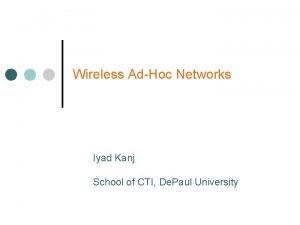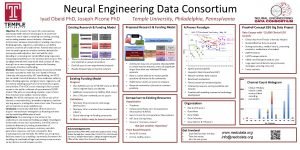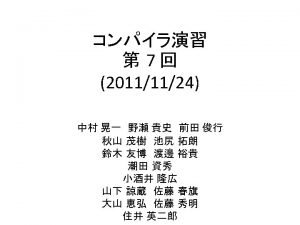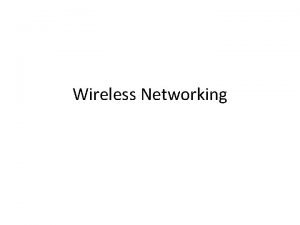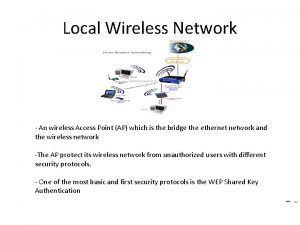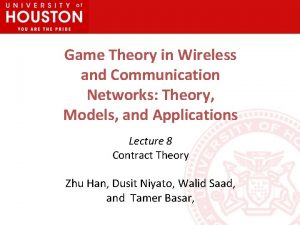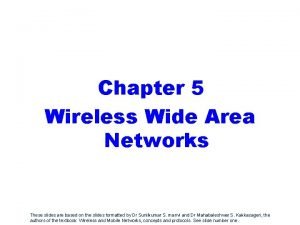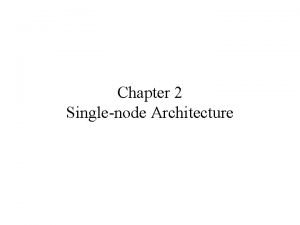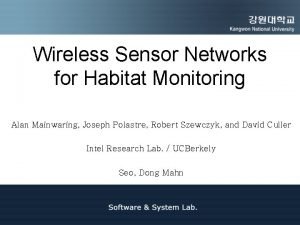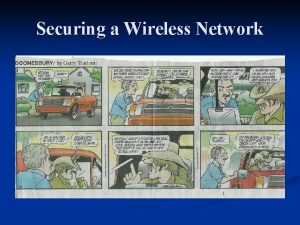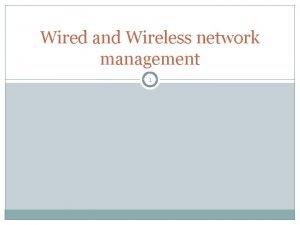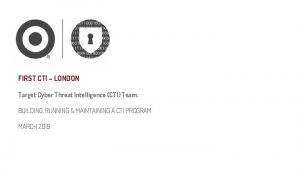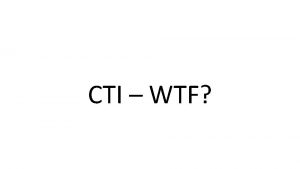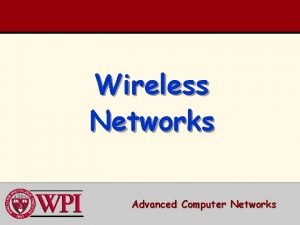Wireless AdHoc Networks Iyad Kanj School of CTI














- Slides: 14

Wireless Ad-Hoc Networks Iyad Kanj School of CTI, De. Paul University

The Internet infrastructure ¢ The Internet provides an infrastructure for communication: Email, WWW, Online games, etc… ¢ The infrastructure consists of fixed, existing cables and hardware routers, etc…

Wireless devices and the Internet ¢ Wireless devices such as your cell phone or PDA make use of the Internet by connecting to its fixed and wired infrastructure through fixed antennas ¢ Wireless devices can then take full advantage of the Internet infrastructure for communication and other applications

No infrastructure? ¢ What if no infrastructure is available? Emergency/rescue operations in deserts, mountains, seas, … l Battlefields l ¢ In all of these cases, a fixed, wired infrastructure does not exist

A Solution A wireless ad hoc network is a decentralized network of mobile devices connected using wireless channels

Wireless Ad Hoc Networks 1

How do devices communicate? ¢ Devices in each others transmission range, i. e. neighbors in the network, communicate directly ¢ What if two distant devices (non-neighbors in the network) need to communicate with each other? l Non-neighbors communicate through messages relayed by intermediate neighbors

How do non-neighbors communicate? Receiver Sender

How is a message routed? ¢ It is not obvious how a message should be routed in a wireless ad-hoc network: • For each message the sending device will consume power proportional to its distance to the receiver device • Each wireless device is typically battery powered and has limited power capacity • Messages between non-neighbors should travel along “shortest paths” in the wireless ad hoc network

Goal ¢ Devise a way to route messages in the network so minimal power is used l In other words, we would like to route messages between sending and receiving devices along “short paths” in the network ¢ Easily done on a fixed, wired Internet ¢ Not so easy on wireless ad-hoc networks because no fixed infrastructure and centralized server exists

Problems ¢ It is unclear how messages should be routed in the wireless ad-hoc network l the network topology should be planar because it is then amenable to guaranteed and efficient routing. planar ¢ Not planar Radio interference issues; devices have limited communication capacities l each device should maintain links to only a few devices in its transmission range

The need for a “sub-network” ¢ Need to construct a bounded-degree planar sub-network of the original network • The sub-network topology should be energy efficient • The construction of the sub-network should be distributed and localized • The sub-network topology should be robust

Other “sub-network” requirements ¢ In a military environment, preservation of security, reliability, and recovery from failure are significant concerns ¢ Military networks are designed to maintain a low probability of intercept and/or a low probability of detection ¢ Hence, nodes prefer to radiate as little power as necessary and transmit as infrequently as possible, thus decreasing the probability of detection or interception

Current work at CTI ¢ At CTI, Prof. Kanj and Prof. Perkovic are investigating the problem of topology control of wireless ad-hoc networks ¢ We have obtained highly efficient algorithms for constructing (near-optimal, in some cases) robust, planar, bounded-degree sub-networks of wireless ad-hoc networks
 Kanj
Kanj Iyad sawalha
Iyad sawalha Iyad obeid
Iyad obeid Ad-hoc polymorphism
Ad-hoc polymorphism Adhoc.com
Adhoc.com Telecommunications the internet and wireless technology
Telecommunications the internet and wireless technology Wireless network definition
Wireless network definition Local wireless networks
Local wireless networks Game theory in wireless and communication networks
Game theory in wireless and communication networks Wireless wide area network
Wireless wide area network Single node architecture in wireless sensor networks
Single node architecture in wireless sensor networks Alan mainwaring
Alan mainwaring Advantages and disadvantages of wired and wireless networks
Advantages and disadvantages of wired and wireless networks Wireless networks
Wireless networks Understanding wired and wireless networks
Understanding wired and wireless networks
